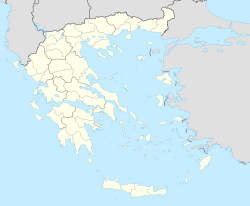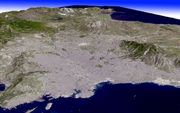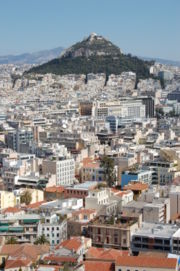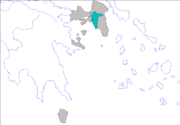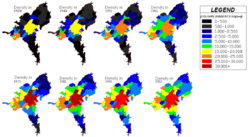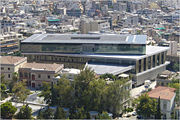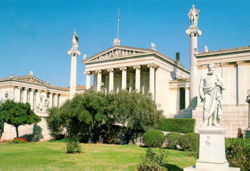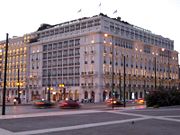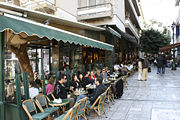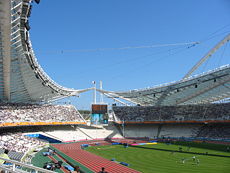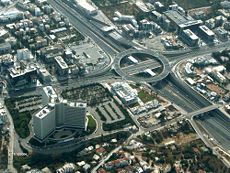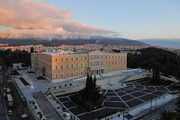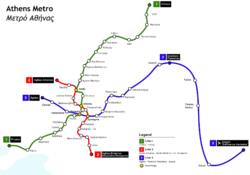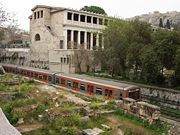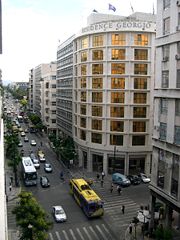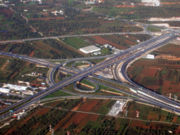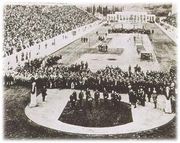Athens
2008/9 Schools Wikipedia Selection. Related subjects: Europe; European Cities
| Athens Αθήνα |
|
|---|---|
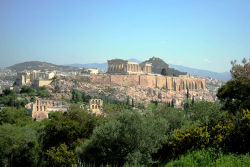 Acropolis of Athens |
|
 |
|
| Location | |
| Coordinates | Coordinates: |
| Time zone: | EET/ EEST ( UTC+2/ 3) |
| Elevation (min-max): | 70 - 338 m (230 - 1109 ft) |
| Government | |
| Country: | Greece |
| Periphery: | Attica |
| Prefecture: | Athens |
| Districts: | 7 |
| Mayor: | Nikitas Kaklamanis ( ND) (since: January 1, 2007) |
| Population statistics (as of 2001) | |
| City Proper | |
| - Population: | 745,514 |
| - Area: | 38.964 km² (15 sq mi) |
| - Density: | 19,133 /km² (49,555 /sq mi) |
| Metropolitan | |
| - Population: | 3,192,606 |
| - Area: | 411.717 km² (159 sq mi) |
| - Density: | 7,754 /km² (20,084 /sq mi) |
| Codes | |
| Postal: | 10x xx, 11x xx, 120 xx |
| Telephone: | 21 |
| Auto: | Yxx, Zxx, Ixx (excluding INx) |
| Website | |
| www.cityofathens.gr | |
Athens (pronounced /ˈæθənz/; Greek: Αθήνα Athina, IPA: [aˈθina]), the capital and largest city of Greece, dominates the Attica periphery: as one of the world's oldest cities, its recorded history spans at least 3,000 years.
The Greek capital has a population of 745,514 (in 2001) within its administrative limits and a land area of 39 km² (15 sq mi). The urban area of Athens extends beyond the administrative city limits with a population of 3.37 million (in 2005). The area of Athens prefecture spans 412 km² (159 sq mi) and encompasses a population of 3,192,606. The Athens Larger Urban Zone (LUZ) is the 8th most populated LUZ in the European Union with a population of 3,894,573 (in 2001). A bustling and cosmopolitan metropolis, Athens is central to economic, financial, industrial, political and cultural life in Greece. It is rapidly becoming a leading business centre in the European Union. In 2008, Athens was ranked the world's 32nd-richest city in a UBS study.
Classical Athens was a powerful city-state. A centre for the arts, learning and philosophy, home of Plato's Academy and Aristotle's Lyceum, Athens was also the birthplace of Socrates, Pericles, Sophocles and its many other prominent philosophers, writers and politicians of the ancient world. It is widely referred to as the cradle of Western civilization and the birthplace of democracy, largely due to the impact of its cultural and political achievements during the 5th and 4th centuries BC on the rest of the then known European continent.
The heritage of the classical era is still evident in the city, represented by a number of ancient monuments and works of art, the most famous of all being the Parthenon on the Acropolis, widely considered a key landmark of early Western civilization. The city also retains a vast variety of Roman and Byzantine monuments, as well as a smaller number of remaining Ottoman monuments projecting the city's long history across the centuries. Landmarks of the modern era are also present, dating back to 1830 (the establishment of the independent Greek state), and taking in the Greek Parliament (19th century) and the Athens Trilogy (Library, University, and Academy). Athens was the host city of the first modern-day Olympic Games in 1896, and 108 years later it welcomed home the 2004 Summer Olympics, with great success.
Origin of the name
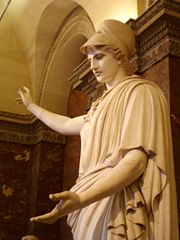
In Ancient Greek, the name of Athens was Ἀθῆναι IPA: [atʰɛ̑ːnaɪ], related tο name of the goddess Athena ( Attic Ἀθηνᾶ [atʰɛːnȃː] and Ionic Ἀθήνη [atʰɛ́ːnɛː]). The city's name was in the plural, like those of Θῆβαι ( Thēbai), Μυκῆναι ( Mukēnai), and Δελφοί ( Delphoi).
In the 19th century, Ἀθῆναι (Athinai / [aˈθinɛ]) was formally re-adopted as the city's name. Since the official abandonment of Katharevousa Greek in the 1970s, Αθήνα (Athína / [aˈθina]) has become the city's official name.
History

Athens has been continuously inhabited for at least 3,000 years. Classical Athens became the leading city of ancient Greece in the 5th century BC, with its cultural achievements laying the foundations of Western civilization. During the Middle Ages, the city experienced decline and then recovery under the Byzantine Empire, and was relatively prosperous during the Crusades, benefiting from Italian trade; after a long period of decline under the rule of the Ottoman Empire, Athens re-emerged in the 19th century as the capital of the independent Greek state, and in 1896 hosted the first modern Olympic Games. In the 1920s a number of Greek refugees, expelled from Asia Minor after the Greco-Turkish War (1919-1922), swelled Athens' population; nevertheless it was most particularly following the Second World War, and from the 1950s and 1960s, that the population of the city exploded, and Athens experienced a gradual expansion in all directions. In the 1980s it became evident that smog from factories and an ever increasing fleet of automobiles, as well as a lack of adequate free space due to overcongestion, had evolved into the city's most important challenges. A series of anti-pollution measures taken by the city's authorities in the 1990s, combined with a substantial improvement of the city's infrastructure (including the Attiki Odos ring road, the dramatic expansion of the Athens Metro, and the brand new Athens International Airport), alleviated pollution considerably and transformed Athens into a much more functional city.
Geography
Athens sprawls across the central plain of Attica, often referred to as the Attica Basin which is bound by Mount Aegaleo in the west, Mount Parnitha in the north, Mount Penteli in the northeast, Mount Hymettus in the east, and the Saronic Gulf in the southwest. The capital has expanded to cover the entire plain, making future growth difficult. The geomorphology of Athens causes the so-called temperature inversion phenomenon, and along with the failure of the Greek Government to control industrial pollution is responsible for the air pollution problems the city has recently faced. (Los Angeles and Mexico City also suffer with similar geomorphology inversion problems). The pollution of Athens was at one point so destructive, that according to the then Greek Minister of Culture, Constantine Trypanis, the carved details on the five caryatids of the Erechtheum have seriously degenerated, while the face of the horseman on the Parthenon's west side is all but obliterated. A series of strict measures then taken by the authorities of the city throughout the 1990s resulted in a dramatic improvement of air quality; the appearance of smog (or nefos as the Athenians used to call it) has become an increasingly rare phenomenon.
Climate
| Climate chart for Athens | |||||||||||
|---|---|---|---|---|---|---|---|---|---|---|---|
| J | F | M | A | M | J | J | A | S | O | N | D |
|
46
13
6
|
48
13
7
|
43
16
8
|
28
20
11
|
18
25
15
|
10
29
20
|
5
32
22
|
5
32
22
|
13
29
19
|
48
23
14
|
51
18
11
|
66
14
8
|
| temperatures in °C precipitation totals in mm source: Weather Channel |
|||||||||||
|
Imperial conversion
|
|||||||||||
Athens enjoys a typical mediterranean climate, with the greatest amounts of precipitation mainly occurring from mid-October to mid-April; any precipitation is sparse during summer and falls generally in the form of showers and/or thunderstorms. Due to its location in a strong rain shadow because of Mount Parnitha, however, the Athenian climate is much drier compared to most of the rest of Mediterranean Europe. The mountainous northern suburbs, for their part, experience a somewhat differentiated climatic pattern, with generally lower temperatures and more substantial snowfalls during winter. Fog is highly unusual in the city centre but it is more frequent to the east, behind the Hymettus mountain range.
Snowfalls occur almost on a yearly basis, though these do not normally lead to significant, if any, disruption. Nonetheless, the city has experienced its share of heavy snowfalls, not least in the past decade. During the blizzards of March 1987; February 1992; January 4-6, 2002; February 12-13, 2004 and February 16-18, 2008, snow blanketed large parts of the metropolitan area, causing havoc across much of the city.
Spring and fall (autumn) are considered ideal seasons for sightseeing and all kinds of outdoor activities. Summers can be particularly hot and at times prone to smog and pollution related conditions (however, much less so than in the past). The average daytime maximum temperature for the month of July is 92.3 °F (33.5 °C) and heatwaves are relatively common, occurring generally during the months of July and/or August, when hot air masses sweep across Greece from the south or the southwest. On such days only temperature maxima soar over 100 °F (37.8 °C).
The all-time high temperatures for the metropolitan area of Athens of 48.0 °C (118.4 °F) were recorded in Elefsina, a suburb of Athens. The respective low-temperature record is −5.8 °C (21.6 °F), recorded at Nea Filadelfia. During the February 2004 blizzard (one of the worst snowstorms ever to hit the city), temperatures plummeted to −7 °C (19.4 °F) at the University Campus, and −10.1 °C (13.8 °F) at the meteorological station of the National Observatory of Athens, in Penteli.
Pollution and environment
Although air pollution remains to some degree an issue for Athens, particularly on the hottest summer days, widespread measures taken by the Greek authorities throughout the 1990s have effectively improved air quality.
In late June 2007, the Attica region experienced a number of brush fires, including one that burned a significant portion of a large forested national park in Mount Parnitha, which is considered critical to maintaining a better air quality in Athens all year round. Damage to the park has led to worries over a stalling in the improvement of air quality in the city.
In January 2007, Athens briefly faced a waste management problem when its landfill near Ano Liosia, an Athenian suburb, reached capacity. Piles of garbage filled the streets, causing pedestrians difficulty. The crisis eased by mid-January when authorities began taking the garbage to a temporary landfill.
Government
Athens is the capital of Greece, but it is also the capital of the Attica Periphery and the Athens Prefecture. The city has been the capital of Greece since 1834, succeeding Nafplion, the city that was provisional capital during the Greek War of Independence ending in 1832.
Attica Periphery
Athens is located within the Attica Periphery, which encompasses the most populated region of Greece, with around 3.7 million people. The Attica Periphery itself is split into four prefectures; they include the Athens Prefecture, Piraeus Prefecture, West Attica Prefecture, and the East Attica Prefecture. It is, however, one of the smaller peripheries in Greece, with an area of 3,808 km² (1,470 sq mi).
Athens Prefecture
The Athens Prefecture is the most populous of all the Greek Prefectures, accounting for well over 2.6 million of the 3.7 million in the Attica Periphery. Athens can refer either to the entire metropolitan area, or to the Municipality of Athens. The next largest municipalities of Athens metropolitan area are the Municipality of Piraeus, the Municipality of Peristeri, and the Municipality of Kallithea. Each of these municipalities has an elected district council and a directly elected mayor.
Athens Municipality
The modern city of Athens consists of what was once a conglomeration of distinct towns and villages that gradually expanded and merged into a single large metropolis; most of this expansion occurred during the second half of the 20th century. The Greater Athens area is now divided into 55 municipalities, the largest of which is the Municipality of Athens or Dimos Athinaion, with a population of 745,514 people.
Dora Bakoyanni, of the conservative New Democracy party, was Mayor of Athens from 1 January 2003 until 15 February 2006, when she joined the Greek cabinet as Minister of Foreign Affairs. During her tenure, she had been the 76th Mayor of Athens, and the first female ever to hold that post in the city's history; later replaced by Theodoros Behrakis. The next municipal elections took place in October 2006, at which time Nikitas Kaklamanis took over as the city's mayor.
The Municipality of Athens is divided into seven municipal districts, or demotika diamerismata. The 7-district division is mainly used for administrative purposes. For Athenians the most popular way of dividing the city proper is through its neighbourhoods, each with its own distinct history and characteristics. Those include Pangrati, Ambelokipi, Exarcheia, Ano Patissia, Kato Patissia, Ilissia, Ano and Kato Petralona, Mets, Koukaki and Kypseli, the world's second most densely populated urban area. For a traveller unfamiliar with Athens, familiarity with the contours of these neighbourhoods can often be particularly useful in both exploring and understanding the city.
Demographics
The municipality of Athens has an official population of 745,514 with a metropolitan population of 3.8 million (population including the suburbs). The actual population, however, is believed to be higher, because during census-taking (carried out once every 10 years) some Athenian residents travel back to their birthplaces, and register as local citizens there.
Reflecting this uncertainty about population figures, various sources refer to a population of around 5 million people for Athens. Also unaccounted for is an undefined number of unregistered immigrants originating mainly from Albania and other Eastern European countries.
The ancient site of the city is centred on the rocky hill of the acropolis. In ancient times the port of Piraeus was a separate city, but it has now been absorbed into greater Athens. The rapid expansion of the city initiated in the 1950s and 1960s continues today, because of the transition from an agricultural to an industrial nation. The expansion is now particularly toward the East and North East (a tendency greatly related to the new Eleftherios Venizelos International Airport and the Attiki Odos, the freeway that cuts across Attica). By this process Athens has engulfed many former suburbs and villages in Attica, and continues to do so. Throughout its long history, Athens has experienced many different population levels. The table below shows the historical population of Athens in recent times.
| Year | City population | Urban population | Metro population |
|---|---|---|---|
| 1833 | 4,000 | - | - |
| 1870 | 44,500 | - | - |
| 1896 | 123,000 | - | - |
| 1921 (Pre-Population exchange) | 473,000 | - | - |
| 1921 ( Post-Population exchange) | 718,000 | - | - |
| 1971 | 867,023 | - | - |
| 1981 | 885,737 | - | - |
| 1991 | 772,072 | - | 3,444,358 |
| 2001 | 745,514 | 3,130,841 | 3,761,810 |
Culture
Archaeological hub
The city is one of the world's main centres of archaeological research. Apart from national institutions, like Athens University, the Archaeological Society, several archaeological Museums (including the National Archaeological Museum, the Cycladic Museum, the Epigraphic Museum, the Byzantine Museum, as well as museums at the ancient Agora, Acropolis, and Kerameikos), the city is also home to the Demokritos laboratory for Archaeometry as well as several regional and national archaeological authorities that form part of the Greek Department of Culture. Additionally, Athens hosts 17 Foreign Archaeological Institutes which promote and facilitate research by scholars from their respective home countries. As a result, Athens has more than a dozen archaeological libraries and three specialized archaeological laboratories, and is the venue of several hundred specialized lectures, conferences and seminars, as well as dozens of archaeological exhibitions, per year. At any given time, Athens is the (temporary) home to hundreds of international scholars and researchers in all disciplines of archaeology.
Tourism
Athens has been a popular destination for travellers since antiquity. Over the past decade, the infrastructure and social amenities of Athens have been radically improved, in part due to the city's successful bid to stage the 2004 Olympic Games. The Greek Government, aided by the EU, has funded major infrastructure projects such as the state-of-the-art Eleftherios Venizelos International Airport, the massive expansion of the Athens Metro system, and the new Attiki Odos Motorway. Home to a vast number of 5 and 4 star hotels, the city is currently the 6th most visited capital.
Entertainment
Athens is home to 148 theatrical stages, more than any other European city, including the famous ancient Herodes Atticus Theatre, home to the Athens Festival, which runs from May to October each year. In addition to a large number of multiplexes, Athens plays host to a variety of romantic, open air garden cinemas. The city also supports a vast number of music venues, including the Athens Concert Hall, known as the "Megaron Moussikis", which attracts world-famous artists all year round.
Sports
The Athens area is home to three prestigious European clubs: Olympiacos, Panathinaikos and AEK Athens, all multi sport clubs. A host of other local clubs are also active in the areas, some listed above. Beach volleyball and windsurfing are both very popular in broader Attica, and nearby beaches are popular with surfers, who have created their own subculture.
Athens has twice played host to the summer Olympic Games: in 1896 and in 2004. The 2004 Summer Olympics inspired the development of the Athens Olympic Stadium, which has gained a reputation as one of the most beautiful in the world. The city has also hosted the UEFA Champions League final twice, in 1994 and in 2007, at the Athens Olympic Stadium and the UEFA Cup Winners' Cup final in 1971 at the Karaiskákis Stadium, a state-of-the-art sports and entertainment complex. Athens has also hosted two Euroleague final fours, the first in 1993 at Peace and Friendship Stadium and the second in 2007 at the Athens Olympic Indoor Hall, and several competitions in other sports.
The Athens area encompasses a variety of terrain, notably hills and mountains rising around the metropolis, and the capital is the only major city in Europe to be bisected by a mountain range. Four mountain ranges extend into city boundaries, and thousands of miles of trails crisscross the city and neighbouring areas, providing exercise and wilderness access on foot, bike, or horse. Beyond Athens and across the county a great variety of outdoor activities are available and popular, including skiing, rock climbing, hang gliding, and windsurfing. Numerous outdoor clubs serve these sports, including the Athens Chapter of the Sierra Club, which leads over 4,000 outings annually in the area.
| Club | Sport | Founded | League | Venue |
|---|---|---|---|---|
| Panathinaikos FC | Football | 1908 | Super League Greece | Apostolos Nikolaidis Stadium |
| AEK Athens FC | Football | 1924 | Super League Greece | Athens Olympic Stadium |
| Olympiacos | Football | 1925 | Super League Greece | Karaiskákis Stadium |
| Panionios | Football | 1890 | Super League Greece | Nea Smyrni Stadium |
| Atromitos | Football | 1950 | Super League Greece | Peristeri Stadium |
| Panathinaikos BC | Basketball | 1922 | A1 Ethniki | Athens Olympic Indoor Hall |
| AEK Athens BC | Basketball | 1928 | A1 Ethniki | Athens Olympic Indoor Hall |
| Olympiacos BC | Basketball | 1925 | A1 Ethniki | Peace and Friendship Stadium |
| Panellinios | Basketball | 1891 | A1 Ethniki | Panellinios Indoor Hall |
| Panionios BC | Basketball | 1890 | A1 Ethniki | Helliniko Arena |
| Maroussi BC | Basketball | 1970 | A1 Ethniki | Maroussi Indoor Hall |
| Panathinaikos VC | Volleyball | 1919 | A1 Ethniki | Glyfada Indoor Hall |
| Olympiacos SC | Volleyball | 1930 | A1 Ethniki | Rendis Indoor Hall |
| AEK Athens VC | Volleyball | 1967 | A1 Ethniki | Nea Filadelfia Indoor Hall |
| Panellinios | Volleyball | A1 Ethniki | Panellinios Indoor Hall | |
| Olympiacos WPC | Water polo | A1 Ethniki | Papastrateio Indoo Hall | |
| Ethnikos Piraeus | Water polo | A1 Ethniki | Papastrateio Hall | |
| Panathinaikos | Water Polo | A1 Ethniki | Athens Olympic Aquatic Centre | |
| Panionios | Water polo | A1 Ethniki | Nea Smyrni Hall | |
| Vouliagmeni | Water polo | 1937 | A1 Ethniki | Vouliagmeni Hall |
| Spartakos Glyfadas | Baseball | 1990 | National Baseball League | Helliniko Baseball Centre |
| Maroussi 2004 | Baseball | 1990 | National Baseball League | Helliniko Baseball Centre |
| Athinaikos | Handball | 1927 | National Handball League | Helliniko Arena |
| Athens Rugby | Rugby | 1990 | National Rugby League | Athens Olympic Stadium |
| Starbucks Rugby | Rugby | 1983 | National Rugby League | Athens Olympic Stadium |
Urban Landscape
Architecture
Athens is a melting pot of many different architectural styles, ranging from Greco-Roman, Neo-Classical, to modern. Many of the most prominent buildings of the city are either Greco-Roman or neo-classical in style. Some of the neo-classical buildings to be found are public buildings erected during the mid-nineteenth century under the guidance of Theophil Freiherr von Hansen:
- Athens Academy
- Athens City Hall
- Greek Parliament
- Old Parliament (1875-1932) (Now the National Historical Museum)
- University of Athens
- Zappeion Hall
The city also holds a number of palaces, such as the Royal Palace and Tatoi, former homes of the Greek monarchs.
Athenian Neighbourhoods
The Municipality of Athens is divided into several districts: Omonoia, Syntagma, Exarcheia, Aghios Nikolaos, Neapolis, Lykavittos, Lofos Strefi, Lofos Finopoulou, Lofos Filopappou, Pedion Areos, Metaxourgeio, Aghios Kostantinos, Larissa Station, Kerameikos, Psirri, Monastiraki, Gazi, Thission, Kapnikarea, Aghia Irini, Aerides, Anafiotika, Plaka, Acropolis, Pnyka, Makrygianni, Lofos Ardittou, Zappeion, Aghios Spyridon, Pangration, Kolonaki, Dexameni, Evaggelismos, Gouva, Aghios Ioannis, Neos Kosmos, Koukaki, Kynosargous, Fix, Ano Petralona, Kato Petralona, Rouf, Votanikos, Profitis Daniil, Akadimia Platonos, Kolonos, Kolokynthou, Attikis Square, Lofos Skouze, Sepolia, Kypseli, Aghios Meletios, Nea Kypseli, Polygono, Ampelokipoi, Panormou-Gerokomeio, Pentagono, Ellinorossoi, Kato Filothei, Ano Kypseli, Tourkovounia-Lofos Patatsou, Lofos Elikonos, Koliatsou, Thymarakia, Kato Patisia, Treis Gefyres, Aghios Eleftherios, Ano Patisia, Kypriadou, Prompona.
Omonia
Omonia Square ( Greek: Πλατεία Ομονοίας) is the oldest square in Athens. It is surrounded by hotels and fast food outlets, and contains a train station used by the Athens Metro and the Ilektrikos, appropriately named Omonoia Station. The square often becomes the focus for celebration of sporting victories, as seen after the country's winning of the Euro 2004 and the Eurobasket 2005 tournaments.
Psirri and Gazi
The reviving Psirri ( Greek: Ψυρρή) neighbourhood - aka Athens's "meat packing district" - is dotted with renovated former mansions, artists' spaces, and small gallery areas. A number of its renovated buildings also now host a wide variety of fashionable bars, making it a hotspot for the city in the last decade, while a number of live music restaurants known as "rebetadika", after Rebetiko, a unique form of music that blossomed in Syros and Athens from the 1920s until the 1960s, are also to be found. Rebetiko is admired by many, and as a result rebetadika are often crammed with people of all ages who will sing, dance and drink till dawn. The Gazi ( Greek: Γκάζι) area, one of the latest in full redevelopment, is located around a historic gas factory, now converted into the Technopolis cultural multiplex, and also includes artists' areas, a number of small clubs, bars and restaurants, as well as Athens' nascent " Gay Village". The metro's system recent expansion to the western suburbs of the city has brought easier access to the area since spring 2007, as the blue line now stops at Gazi ( Kerameikos station).
Syntagma
Syntagma Square, ( Greek: Σύνταγμα), is the capital's central square, lying adjacent to Parliament and the city's most noted hotels. Ermou Street, an approximately 1 km-long pedestrian road connecting Syntagma Square to Monastiraki, has traditionally been a consumer paradise for both Athenians and tourists. Complete with fashion shops and shopping centres promoting most international brands, it now finds itself in the top 5 most expensive shopping streets in Europe, and the tenth most expensive retail street in the world. Nearby, the renovated Army Fund building in Panepistimiou Street includes the "Attica" department store and several upmarket designer stores.
Plaka, Monastiraki, and Thission
Plaka ( Greek: Πλάκα), lying just beneath the Acropolis, is famous for its plentiful neoclassical architecture, making up one of the most scenic districts of the city. It remains a traditionally prime tourist destination with a number of picturesque tavernas and live performances. Nearby Monastiraki ( Greek: Μοναστηράκι), for its part, is well-known for its string of small shops and markets, as well as its crowded flea market and tavernas specialising in souvlaki. Another district notably famous for its student-crammed, stylish cafés is Theseum or Thission ( Greek: Θησείο), lying just west of Monastiraki. Thission is home to the remarkable ancient Temple of Hephaestus, standing atop a small hill.
Kolonaki
The Kolonaki ( Greek: Κολωνάκι) area, at the base of Lycabettus hill, is full of boutiques catering to well-heeled customers by day, and bars and more fashionable restaurants by night, but at other points also a wide range of art galleries and museums. This is often regarded as one of the more prestigious areas of the capital.
Exarcheia
Exarcheia ( Greek: Εξάρχεια), located north of Kolonaki, has a mixed reputation as the recent or current location of the city's anarchist and drug scenes and as a culturally active student quarter with many cafés, bars and bookshops. Exarcheia is home to the Athens Polytechnic and the National Archaeological Museum; it also contains numerous important buildings of several 20th-century styles: Neoclassicism, Art Deco and Early Modernism (including Bauhaus influences).
Suburbs
The Athens Metropolitan Area consists of 73 densely populated municipalities, sprawling around the city in virtually all directions. According to their geographic location in relation to the city of Athens, the suburbs are divided into four zones; the northern suburbs (including Ekali, Nea Erythrea, Agios Stefanos, Drosia, Kryoneri, Kifissia, Maroussi, Pefki, Lykovrisi, Heraklio, Glyka Nera, Vrilissia, Melissia, Pendeli, Halandri, Psychiko and Filothei); the southern suburbs, (including Palaio Faliro, Elliniko, Glyfada, Alimos, Voula and the southernmost suburb of Vouliagmeni); the eastern suburbs, (including Zografou, Vyronas, Kaisariani, Cholargos, Papagou and Aghia Paraskevi; and the western suburbs (including Peristeri, Ilion, Egaleo, Petroupoli and Nikaia). The northern and most of the southern suburbs are particularly affluent districts, inhabited primarily by middle-to-high and high income groups. The western suburbs are primarily resided in by middle income earners, with some areas resided in by middle-to-low income groups and still others by middle-to-high earners; while the eastern suburbs are primarily inhabited by middle and middle-to-high income groups.
The Athens city coastline, extending from the major commercial port of Piraeus to the southernmost suburb of Varkiza for some 50 km (30 mi), is also connected to the city centre by a tram (which, although modern, can be slow during rush hour), and is punctuated by a string of popular restaurants, cafes, vibrant music venues and modern sports facilities. The area is particularly packed with fashionable bars and nightclubs, that are literally crowded by the city's youth on a daily basis. Most of all during the summer months, the elegant coastal suburbs of Glyfada, Voula and Vouliagmeni host countless such meeting-points, continuing the length of Poseidonos Avenue and Alkyonidon Avenue.
In the winter months, the focus of the city's nightlife moves up into the city centre, in Piraeus as well as across the northern suburbs. In addition, "Bournazi", at the western suburb of Peristeri, has also gained a reputation for its intense nightlife, having turned itself into a hotspot principally for residents of the western Athenian suburbs. In the northern districts, the attractive suburb of Kifissia again hosts a vast number of fashionable restaurants, bars and cafés.
The Mall Athens is a massive mall located in the northern suburb of Maroussi, providing an array of outlets. Nearby, the entirely new attraction of the massively upgraded main Olympic Complex (known by its Greek acronym OAKA) dominates the skyline. The whole area has been redeveloped according to a design by the Spanish architect Santiago Calatrava, with steel arches, landscaped gardens, fountains, futuristic glass, and a landmark new blue glass roof which was added to the main stadium. A second Olympic complex, next to the sea at the beach of Kallithea (Faliron), also features modern stadia, shops and an elevated esplanade. Work is underway to transform the grounds of the old Athens Airport - named Hellinikon - in the southern suburbs, into one of the largest landscaped parks in Europe, to be named the Hellenikon Metropolitan Park.
The major waste management efforts undertaken in the last decade (especially the plant built on the small island of Psytalia) have improved water quality in the Saronic Gulf, and the coastal waters of Athens are now accessible again to swimmers. Many of the southern suburbs (such as Alimos, Palaio Faliro, Elliniko, Voula, Vouliagmeni and Varkiza) host a number of sandy beaches, most of which are operated by the Greek National Tourism Organisation and require an entrance fee. Fees are not excessive in most cases, and include a number of related conveniences.
The city is surrounded by four mountains; ( Parnitha and Penteli accessible to the north, Hemmettus to the southeast, and Egaleo to the west). Mount Parnitha, in particular, is the tallest of the city (1,453 m (4,767 ft)) and has been declared a national park. Tens of well-marked paths, gorges, springs, torrents and caves dot the area, and one may even encounter deer in its dense forest. Hiking and mountain-biking in all four mountains have been and remain popular outdoor activities for many Athenians. Casinos operate on both Mount Parnitha, some 30 km (19 mi) from downtown Athens, (accessible by car or cable car) and the nearby town of Loutraki (accessible by car via the Athens - Corinth National Highway, or the suburban railroad).
Landmarks
Large parts of the city centre have been redeveloped under a masterplan called Unification of Archeological Sites of Athens, which has also gathered funding from the EU to help enhance the project. Most strikingly, the landmark Dionysiou Aeropagitou street has been pedestrianised, forming a scenic route. The route starts from the Temple of Olympian Zeus at Vasilissis Olgas Avenue, continues under the southern slopes of the Acropolis near Plaka, and finishes just beyond the Temple of Hephaestus in Thiseio. The route in its entirety provides visitors with views of the Parthenon and the Agora (the meeting point of ancient Athenians), away from the busy city centre.
- Syntagma Square (Constitution Square) is situated in central Athens and near the site of the former Royal Palace, now the Greek Parliament and other 19th century public buildings. The National Garden behind parliament, stretching to the Zappeion, is a verdant oasis for the city-centre. Syntagma is the largest square in the capital and also home to a number of luxury hotels, including the historic Grande Bretagne, Athens' first. Constitution Square is a tourist starting-point for the city, at the centre of an area where most of its famous ancient monuments are to be found, all within a 2 km (1 mi) radius.
- Southeast of Syntagma Square stands the Kallimarmaro Stadium, the space where the first modern Olympic Games took place in 1896. It is a replica of the ancient Athenian stadium, and the only major stadium (in its capacity of 60,000) to be made entirely of white marble from Mount Penteli, the same material used for the construction of the Parthenon.
- Athens is built around a number of hills. Lycabettus is one of the tallest hills of the city proper and according to ancient legend is actually a boulder thrown down from the sky by Athena. Located in the city centre, near Alexandras Avenue and Vassilissis Sofias Avenue, it offers vistas of sprawling Athens below. At its peak stands St. George's church; Philopappos hill is another famous landmark, located just to the southwest of Acropolis.
- The city's classical museums include the National Archaeological Museum of Athens at Patission Street (housing the world's greatest collection of Greek art), the Benaki Museum in Pireos Street (including its new Islamic Art branch), the Byzantine Museum and the Museum of Cycladic Art ( Stathatos Mansion) in the central Kolonaki district, recommended for its collection of elegant white metamodern figures dating back 3000 years. Most museums were renovated ahead of the 2004 Olympics. A New Acropolis Museum, is scheduled to open in mid 2008 in the Makriyanni district, designed by Swiss-French architect Bernard Tschumi. The Athens Planetarium, located in Andrea Syngrou Avenue, is considered among the world's best.
- The old campus of the University of Athens, located in the middle section of Panepistimiou Street, is one of the finest buildings in the city. This, combined with the adjacent National Library and the Athens Academy close by, form an imposing "Athens Trilogy" built in the mid-19th century. However, most of the university's workings have been moved to a much larger, modern campus located in the eastern suburb of Zográfou. The second most significant academic institution in the city is the Athens Polytechnic School (Ethniko Metsovio Politechnio), to be found in Patission Street. More than 20 students were killed inside the university in November 17, 1973 during the Athens Polytechnic Uprising, against the military junta that ruled the nation from April 21, 1967 until July 23, 1974.
Transportation
The Athens Mass Transit System consists of a large bus fleet, a trolleybus fleet that mainly serves the downtown area, the city's Metro, a tram line connecting the southern suburbs to the city centre, and the Athens Suburban Railway service.
Attiko Metro
The Athens Metro is more commonly known in Greece as the Attiko Metro ( Greek: Αττικό Mετρό). While its main purpose is transport, it also houses Greek artifacts found during construction of the subway. The Athens Metro supports an operating staff of 387 and runs two of the three metro lines; its two lines (red and blue) were constructed largely during the 1990s, and the initial sections opened in January 2000, and the lines run entirely underground. The metro network operates a fleet of 42 trains consisting of 252 cars, with a daily occupancy of 550,000 passengers. The Blue Line runs from the western suburbs, namely the Egaleo station, through the central Monastiraki and Syntagma stations to Doukissis Plakentias avenue in the northeastern suburb of Halandri, covering a distance of 16 km (10 mi), then ascending to ground level and reaching Eleftherios Venizelos International Airport, using the Suburban Railway infrastructure and extending its distance to 39 km (24 mi). The Red Line, in counterpart, runs from Aghios Antonios to Aghios Dimitrios and covers a distance of 11.6 km (7 mi). Extensions to both these lines are under construction, most notably westwards to Piraeus, southwards to the Old Hellinikon Airport East Terminal (the future Metropolitan Park), and eastward toward the easternmost suburb of Aghia Paraskevi. The eastern part is actually no extension per se, but rather an opening of new stations between the Ethniki Amyna and Doukissis Plakentias stations. The spring 2007 extension from Monastiraki westwards, to Egaleo, connected some of the main night life hubs of the city, namely the ones of Gazi ( Kerameikos station) with Psyrri ( Monastiraki station) and the city centre ( Syntagma station).
Electric railway (ISAP)
The third line, not run by the Athens Metro, is the ISAP ( Greek: ΗΣΑΠ), the Electric Railway Company. This is the Green line of the Athens Metro as shown on the adjacent map, and unlike the red and blue routes running entirely underground, ISAP runs either above-ground or below-ground at different sections of its journey. This same operation runs the original metro line from Piraeus to Kifisia; it serves 22 stations, with a network length of 25.6 km (15.9 mi), an operating staff of 730 and a fleet of 44 trains and 243 cars, and a daily occupancy rate of 600,000 passengers. The historic Green Line, a 25 km (16 mi)-long and 24-station line which forms the oldest and for the most part runs at ground level, connects the port of Piraeus to the northern suburb of Kifissia, and is set to be extended to Agios Stefanos, a suburb located 23 km (14 mi) to the north of the city centre, reaching to 36 km (22 mi).
Suburban rail (Proastiakos)
The Proastiakós connects Eleftherios Venizelos International Airport to the city of Corinth, 80 km (50 mi) west of Athens, via the central Larissa train station and the port of Piraeus, and is sometimes considered the fourth line of the Athens Metro. The metro network, Suburban Rail not included, currently extends to a length of 91 km (57 mi), expected to stretch to 124 km (77 mi) (72 stations) by 2009. The Proastiakos will be extended to Aigio (180 km (112 mi) west of Athens), and Chalkida by the end of 2007. The urban and suburban railway system is managed by three different companies; namely ISAP, Attiko Metro (lines 2 & 3) and Proastiakós (line 4).
Buses
The service operated under Ethel ( Greek: ΕΘΕΛ) Thermal Bus Company is the main operator of buses in Athens. It consists of a network of 300 bus lines which span the entire Attica Basin, with an operating staff of 5,327, and a fleet of 1,839 buses. Of those 1,839 buses 295 run on natural gas, making up the largest fleet of natural gas-run buses in Europe.
Besides being served by a fleet of natural-gas and normal buses, the Athens metropolitan area is also serviced by electric buses, or ILPAP, as the service is known in Athens ( Greek: ΗΛΠΑΠ). The Electric Buses of the Athens and Pireaus Region (ILPAP) consists of 22 lines and an operating staff of 1,137, and the network operates a fleet of 366 trolley buses able to run on diesel in case of power failure.
Tram line
The tram operator has a fleet of 42 trams which serve 48 stations, employ 345 people with an average daily occupancy of 80,000 passengers. This network runs from Syntagma Square to the southwestern suburb of Palaio Faliro, where the line splits in two branches; the first runs along the Athens coastline toward the southern suburb of Voula, while the other heads toward the Piraeus district of Neo Faliro. The Syntagma - Palaio Faliro - Neo Faliro line and the part Syntagma - Glyfada of the Syntagma - Voula line opened on 19 July 2004. The extension Glyfada - Voula opened in November 2007. Further extensions are planned towards the major commercial port of Piraeus, and the southernmost suburb of Vouliagmeni.
Taxis
There is a plentiful supply of taxis in Athens. They are generally cheap, and during rush hour it is often considered normal to flag down a taxi when not more than one or two other customers are already in (although, officially, this is forbidden); convention dictates that if the second passenger happens to be heading in a similar direction and the original passenger has no complaints (seldom if ever is this an issue), he/she joins the journey, and both passengers give the fare as they would if travelling alone.
Eleftherios Venizelos International Airport
Athens is served by the state-of-the-art Eleftherios Venizelos International Airport (AIA) located near the town of Spata, in the eastern Messoghia plain, some 35 km (22 mi) east of Athens. The airport was awarded the "European Airport of the Year 2004" Award. Intended as an expandable hub for air travel in southeastern Europe, it was constructed in a record 51 months costing 2.2 billion euros, and employing a staff of 14,000. An express bus service is provided, connecting the airport to the metro system, and 2 express bus services connect the airport to the port at Piraeus and the city centre respectively. Eleftherios Venizelos accommodates 65 landings and take-offs per hour, with its 24 passenger boarding bridges, 144 check-in counters and broader 150,000 m² (1,614,587 sq ft) main terminal, and a commercial area of 7,000 m² (75,347 sq ft) which includes cafes and duty-free shops. In 2007, the airport handled 16,538,390 passengers, an increase of 9.7% over the previous year of 2006. Of those 16,538,390 passengers, 5,955,387 passed through the airport for domestic flights, and 10,583,003 passengers travelled through for international flights. Beyond the dimensions of its passenger capacity, AIA handled 205,294 total flights in 2007, or approximately 562 flights per day.
Railways, highways and ferry connections
Athens is the hub of the country's national railway system (OSE), connecting the capital with major cities across Greece and abroad (Istanbul, Sofia, and beyond). However, this system is not very extensive, due largely to geomorphological factors. Ferries departing from the major port of Piraeus connect the city to the numerous Greek islands of the Aegean Sea. There are two main highways; one heading towards the western city of Patra in Peloponessus ( GR-8A, E94) and the other heading to the north, towards Greece's second largest city, Thessaloniki ( GR-1, E75). In 2001-2004, a ring road toll-motorway ( Attiki Odos) was gradually completed, extending from the western industrial suburb of Elefsina all the way to the Athens International Airport. The Ymittos Periphery Highway is a separate section of Attiki Odos connecting the eastern suburb of Kaisariani to the northeastern town of Glyka Nera; this is where it meets the main part of the ring road. The span of the Attiki Odos in all is 70 km.
Olympic Games
1896 Summer Olympics
1896 brought forth the revival of the modern Olympic Games, by Frenchman Pierre de Coubertin. Thanks to his efforts, Athens was awarded the first modern Olympic Games. In 1896, the city had an approximate population of 123,000 and the event helped boost the city's international profile. Of the venues used for these Olympics, the Kallimarmaro Stadium, and Zappeion were most crucial. It was to be more than 100 years before the city would restage the event.
1906 Summer Olympics
The 1906 Summer Olympics, or the 1906 Intercalated games, were held very successfully in Athens. The intercalated competitions were intermediate games to the internationally organised olympics, and were meant to be organised in Greece. This idea later lost support from the IOC and these games were not made permanent.
2004 Summer Olympics
Athens was awarded the 2004 Summer Olympics on September 5, 1997 in Lausanne, Switzerland, after having lost a previous bid to host the 1996 Summer Olympics, to Atlanta, United States. It was to be the second time Athens would have the honour of hosting the games, following the inaugural event of 1896. After 1990's unsuccessful bid, the 1997 bid was radically improved also including an appeal to Greece's Olympic history. In the last round of voting, Athens defeated Rome with 66 votes to 41. Prior to this round, the cities of Buenos Aires, Stockholm and Cape Town had already been eliminated from competition, having received fewer votes.
During the first three years of preparations, the International Olympic Committee had repeatedly expressed some concern over the speed of construction progress for some of the new Olympic venues. In 2000 the Organising Committee's president was replaced by Gianna Angelopoulos-Daskalaki, who was the president of the original Bidding Committee in 1997. From that point on, preparations continued at a highly accelerated, almost frenzied pace.
Although the heavy cost was criticized, estimated at $1.5 billion, as is usually the case with most Olympic cities, Athens was literally transformed into a more functional city that enjoys state-of-the-art technology both in transportation and in modern urban development. Some of the finest sporting venues in the world were created in the city, all of which were fully ready for the games. The games welcomed over 10,000 athletes from all 202 countries. The 2004 Games were judged a huge success, as both security and organization were exceptionally good, and only a few visitors reported minor problems mainly concerning accommodation issues. The 2004 Olympic Games were described as Unforgettable, dream Games, by IOC President Jacques Rogge for their return to the birthplace of the Olympics, and for superbly meeting the challenges of holding the Olympic Games. The only observable problem was a somewhat sparse attendance of some early events. Eventually, however, a total of more than 3.5 million tickets were sold, which was higher than any other Olympics with the exception of Sydney (more than 5 million tickets were sold there in 2000).
Sister cities
Athens has the following sister cities:
|
|
Cities nicknamed "Athens"
- Athens of Cuba - Matanzas, Cuba
- Athens of Egypt- Alexandria, Egypt
- Athens of Finland - Jyväskylä, Finland
- Athens of Florida - DeLand, Florida, USA
- Athens of Indiana - Crawfordsville, Indiana, USA
- Athens of Latin America - Santo Domingo, Dominican Republic
- Athens of Minas Gerais - Juiz de Fora, Brazil
- Athens of North America - Boston, USA
- Athens of Sicily - Catania, Italy
- Athens of South America - Bogotá, Colombia
- Athens of the Bodrog – Sárospatak, Hungary
- Athens of the East - Madurai, India
- Athens of the North - Edinburgh, Scotland
- Athens of the South - Nashville, USA
- Athens of the Southern Hemisphere - Dunedin, New Zealand
- Athens of the West (early 19th c.) - Lexington, USA
- Athens of the West - Berkeley, California, USA
- Athens on the Isar - Munich, Germany
- Athens on the Spree - Berlin, Germany
- Brazilian Athens - São Luís, Maranhão, Brazil
- Czech Athens – Krnov, Czech Republic
- Lusa Athens - Coimbra, Portugal
- Sardinian Athens - Nuoro, Italy
- Serbian Athens - Novi Sad, Serbia
- Siberian Athens - Tomsk, Russia
